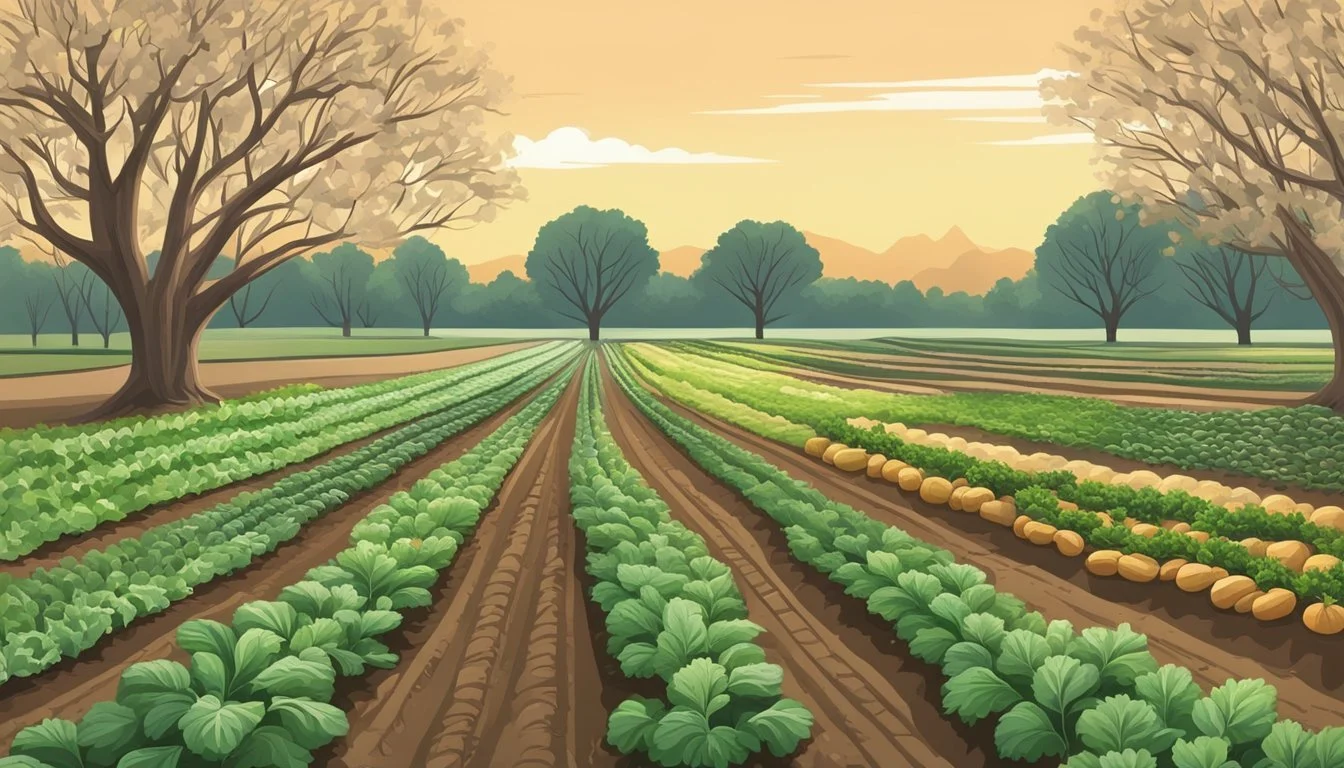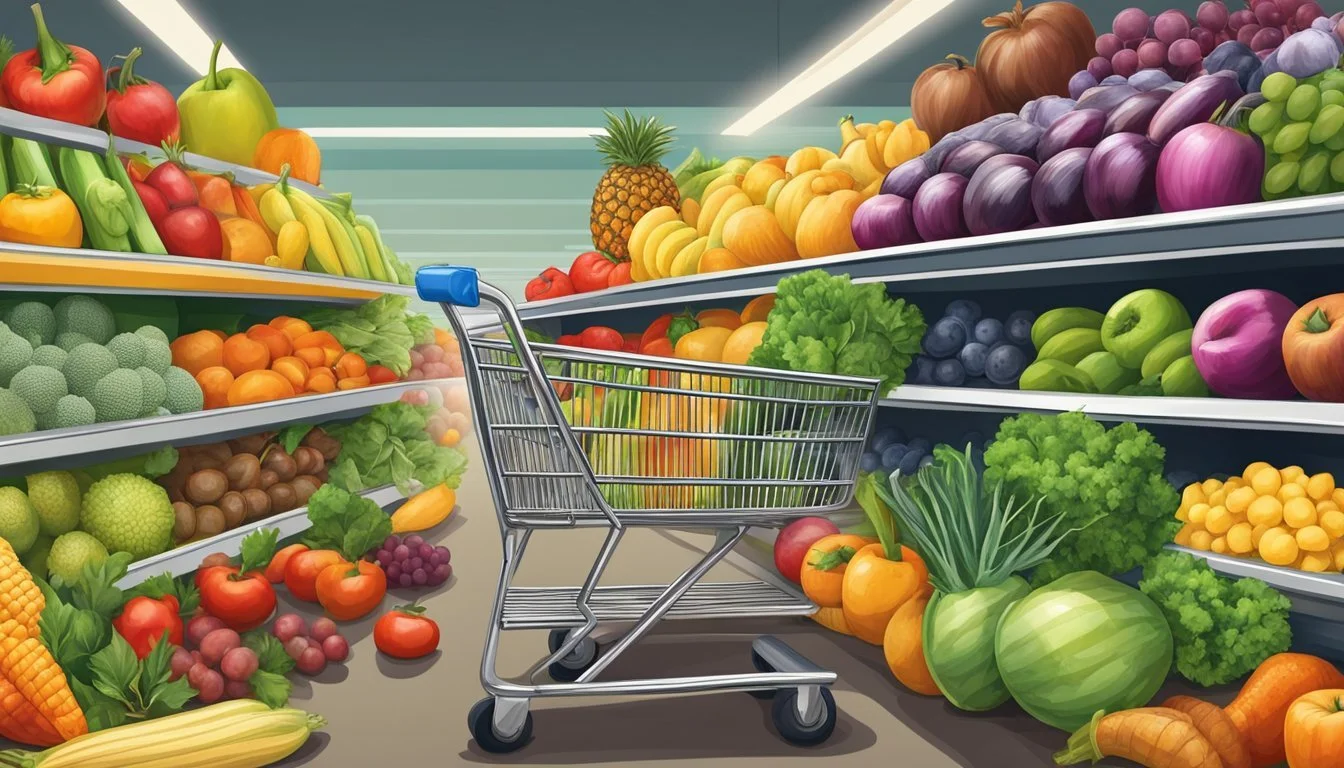Texas Seasonal Fruit & Vegetables in February
Your Fresh Guide
In Texas, February is a time when the chill of winter begins to soften, leading to a mild and conducive environment for growing a variety of fruits and vegetables. During this month, the state's agricultural richness comes to the fore, offering produce that is not only fresh but also packed with essential vitamins and minerals. Seasonal produce in Texas offers an array of health benefits, as the fruits and vegetables available are at their peak in both flavor and nutritional content.
Amongst the fruits, citrus varieties such as oranges and grapefruits continue to thrive and are readily available across local markets. These citrus fruits are well-regarded not just for their juiciness and taste, but also for their high vitamin C content, which is crucial for immune system support during the colder days of the year. Lemons, limes, and a selection of other citrus fruits also offer an abundance of flavors for a variety of culinary uses while providing additional nutritional benefits.
Turning to vegetables, leafy greens like kale (What wine goes well with kale?) and hearty offerings such as cabbage are still in full swing come February. These vegetables are lauded for their low-calorie profile and high concentrations of vitamins A, C, K, and minerals like calcium and iron, reinforcing healthy eating habits. Also in season are root vegetables like carrots (how long do carrots last?), which are versatile in the kitchen and revered for their high vitamin A content, contributing to eye health and immune function.
Overview of Texas Seasonal Produce
In February, Texans enjoy a variety of fresh, seasonal produce. The state's vast climate variations allow for a wide assortment of fruits and vegetables to thrive during this month.
Seasonal Fruits:
Citrus fruits, such as oranges and grapefruits, are especially juicy and flavorful at this time of year.
Seasonal Vegetables:
Root vegetables like beets and turnips maintain their prime status from earlier winter months.
Leafy greens, including kale and cabbage, are also abundant.
Broccoli (how long does broccoli last?)and cauliflower are robust choices that continue to be harvested.
Fresh Produce Availability in February Citrus Fruits High Beets High Turnips High Kale High Cabbage High Broccoli High Cauliflower High
Residents and chefs across the state take advantage of the freshly available local goods, enjoying the rich variety that spans from sweet, tangy fruits to earthy, nutritious vegetables. It's an excellent month to sample some of the best and freshest flavors that Texas has to offer.
Winter Harvest: Fruits and Vegetables Available
Texas offers a bounty of fresh produce even in the chill of February. The seasonal availability ensures that even in winter, one can enjoy a variety of flavors and nutritional options, with citrus fruits and root vegetables taking center stage.
Citrus Fruits in Season
Oranges and Grapefruit reign supreme during the Texas winter. The state's mild winter climate allows these citrus varieties to thrive, offering tangy and vitamin C-packed options for those seeking to maintain health during the colder months.
Oranges: Typically available, providing a fresh, sweet burst of flavor.
Grapefruit: Continues to be a staple, with its juicy and slightly tart notes.
Root Vegetables and Cruciferous Selections
The cool season is ideal for growing a myriad of Root Vegetables and Cruciferous Vegetables. These are not only hardy but are also packed with nutrients and flavors that are perfect for hearty winter meals.
Carrots: Offer a sweet and crunchy option, ideal for both raw and cooked dishes.
Sweet Potatoes: Provide a versatile and vitamin-rich choice for a variety of recipes.
Turnips: Can be found during this time, offering earthy tones to winter dishes.
In the realm of leafy greens, Cabbage and Kale stand out:
Cabbage: Comes in several varieties, all of which are excellent for salads, sautéing, or fermenting.
Kale: Remains a nutritious green, popular for its dense vitamin content and versatility in cooking.
Health Benefits of Seasonal Consumption
Consuming seasonal fruits and vegetables provides numerous health advantages. Individuals who incorporate these foods into their diet typically ingest a higher amount of vitamins, minerals, and fiber, which are crucial for a healthy body.
Nutritious Choices: Seasonal produce tends to be more nutritious as it is harvested at its peak. This ensures a higher content of antioxidants and phytonutrients which are essential for combating diseases.
Vitamin Rich: Fruits and vegetables picked during their appropriate seasons are often richer in vitamins. For instance, citrus fruits like oranges and grapefruits available in February are high in Vitamin C.
Mineral Content: Fresh, in-season produce also provides a variety of minerals. Root vegetables, available during winter months in Texas, contain potassium, magnesium, and other minerals vital for health.
Digestive Health: High in fiber, seasonal fruits and vegetables support digestive health. Fiber aids in regular bowel movements and helps maintain gut health.
Immune Support: Many seasonally available foods boost the immune system. For example, foods rich in Vitamin C, such as kale and cabbage, are abundant and can help strengthen the immune response.
Eating seasonal produce also ensures a healthy diet throughout the year, as it allows for a rotating variety of foods. This not only contributes to a more balanced intake of nutrients but also introduces the palate to a wide range of flavors and textures, promoting a healthy relationship with food.
Recipes Incorporating February Produce
Texas seasonal produce in February provides a robust palette for creating comforting warm dishes and vibrant fresh sides. Utilizing these ingredients ensures the flavors of the season shine in every recipe.
Warm Soups and Stews
Hearty soups and stews are a cornerstone of winter meals, offering warmth and comfort on chilly February days. A classic Minestrone can be adapted using Texas's seasonal vegetables such as cabbage, carrots, and celery root. For added bulk, one may incorporate turnips or rutabagas, chunked and simmered until tender.
A simple yet flavorful broccoli soup showcases the cruciferous vegetable excellently, enhanced with puréed cauliflower for creaminess without added dairy. One might also try a rich beef stew, thick with Texas mushrooms and leeks, the beef meltingly tender, the broth deep with umami.
Fresh Salads and Sides
February in Texas also signals the arrival of crisp salads and light side dishes brimming with freshness. An eclectic mix of purple sweet potatoes, radishes, and shallots, perhaps roasted for a sweet and earthy side, is versatile and vibrant. A tangy kohlrabi slaw, julienned and tossed with a citrus vinaigrette, can offer a crisp counterpoint to heartier dishes.
Stir-fry fans can rejoice in the season with a quick dish of purple broccoli and Brussels sprouts, their flavors brightened with a splash of soy and a hit of ginger. One can't miss out on leveraging parsnips, thinly sliced and roasted or folded into a gratin, each layer echoing the earthy tones of winter transitioning into spring.
Agricultural Practices in Texas
In Texas, the agricultural practices have evolved to adapt to the region's diverse environment and to optimize the relatively long growing season. The state's vast tracts of land and varied climates support a wide range of fruits and vegetables, making Texas a key player in U.S. agriculture.
Environment: Texas's environment plays a crucial role in agricultural productivity. With its multiple climate zones ranging from desert in the west to humid in the east, farmers must be adept at selecting crops suited to their local conditions.
Soil Management: Soil health is a prime focus, with techniques including crop rotation, cover cropping, and controlled irrigation being widely implemented to combat the challenges of occasional droughts and preserve valuable water resources. Farmers actively work to maintain soil fertility, often utilizing both organic and conventional means.
Water Management: Texas's variable rainfall patterns demand efficient water management. Many farmers utilize drip irrigation systems to minimize water waste, crucial in an environment where water conservation is essential. Water use is meticulously managed, especially during the state's hot summers.
Growing Season: The state benefits from a long growing season, allowing for the production of various crops throughout the year. This includes the February harvest, where despite cooler temperatures, certain fruits and vegetables continue to thrive.
Crop Planting Harvesting Kale Fall Winter/Early Spring Cabbage Fall Winter/Early Spring
These practices underscore a commitment to sustainable agriculture and efficient production that characterizes Texas's approach to farming, ensuring that the state remains at the forefront of the American produce market.
Shopping and Storage Tips
When shopping for seasonal fruits and vegetables in Texas during February, look for items that are ripe and fresh. The characteristic signs of ripeness vary: blood oranges should have a slight give when gently squeezed, indicating juiciness, while vegetables such as carrots should be firm and vibrant in color.
For fruits:
Blood Oranges: Store in the refrigerator where they can last up to two weeks.
Kiwis: Keep at room temperature until ripe, then refrigerate.
Pomegranates: Refrigerate to extend shelf life for up to a month.
Strawberries: Place in the refrigerator; do not wash until ready to consume.
For vegetables:
Collard Greens (how long do collard greens last?): Refrigerate in a plastic bag; consume within a few days.
Kale: Refrigerate in a tightly-sealed bag to retain moisture; use within three to five days.
Carrots: Keep in the crisper drawer of the refrigerator, ideally in a sealed bag.
Cabbage: Store whole heads in the refrigerator where they can last several weeks.
Spinach: Refrigerate and consume within a week for optimal freshness.
To maintain the quality of the produce, consumers should keep fruits and vegetables separate in storage, as some fruits emit ethylene gas that can accelerate the ripening and spoilage of vegetables. Additionally, one should be mindful to avoid overcrowding in storage spaces, providing adequate air circulation to prevent premature spoilage.
Upcoming Seasonal Shifts to Anticipate
As February wanes, Texas agriculture prepares for a seasonal transition, with several crops reaching their peak and new varieties beginning to make their appearance.
Early Spring Harvest Preview
In March, Texans can look forward to the arrival of early spring produce. Chief among them is asparagus (What wine goes well with asparagus?), a perennial favorite that thrives in the warming soil. It's a versatile vegetable known for its tender spears and is often heralded as one of the first signs of spring.
Another early spring arrival is strawberries, which start to sweeten as the days lengthen and temperatures gently rise. By April, these berries become more abundant, gracing markets with their vibrant red hues and juicy flavor.
Transitioning Crops
As the state transitions from the cool days of winter to the milder days of spring, peas begin to emerge. Garden peas and sugar snap peas are particularly sought after for their crispness and sweet taste.
Here's a snapshot of what to expect:
Month Crop Status March Asparagus Beginning of the season March Strawberries Early season with increasing availability April Asparagus In full season April Strawberries Peak season March-April Peas Starting and in season
These upcoming shifts not only signal a change in the calendar but also cue a fresh rotation of produce to enjoy on Texas tables.








